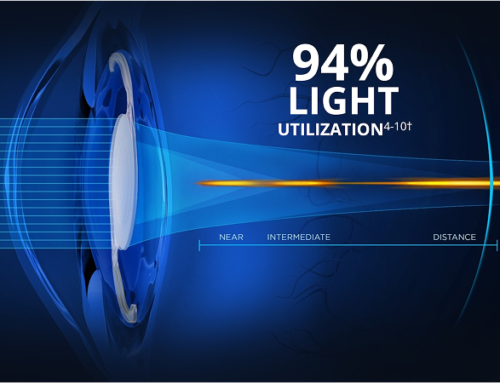Eyesight is precious, and maintaining clear vision becomes a priority as we age. For those facing specific eye conditions like presbyopia, astigmatism, and cataracts, Intraocular Lenses (IOLs) offer a life-changing solution. Here we’ll help you understand the role of IOLs in treating various eye conditions, aiding you in making informed decisions about your eye care.
IOLs for Presbyopia

Presbyopia is an age-related condition that affects everyone over 40. It causes difficulty focusing on nearby objects because the lens inside the eye loses its flexibility.
Addressing Presbyopia with IOLs
The primary treatment for presbyopia involves using multifocal IOLs, which are designed to provide clear vision at multiple distances. Unlike traditional lenses, which only correct distance vision, multifocal IOLs help you see up close, far away, and everything in between.
Types of IOLs for Presbyopia
There are several types of IOLs available for treating presbyopia:
- Multifocal IOLs: These provide focus at various distances.
- Accommodating IOLs: These lenses move or change shape inside the eye, mimicking the eye’s natural focusing ability.
- Extended Depth of Focus (EDOF) IOLs: These offer a continuous range of vision, reducing the need for glasses.
There are different types of eye care options, each with its own pros and cons. It’s important to talk to your eye care provider to determine which one is best for you.
Benefits of Presbyopia-Correcting IOLs
Patients who opt for IOLs to correct presbyopia often experience several benefits:
- Reduced Dependence on Glasses: Many people no longer need glasses for most activities.
- Improved Quality of Life: Clearer vision enhances daily activities, from reading to driving.
- Long-Term Solution: IOLs permanently fix presbyopia, unlike temporary solutions like reading glasses.
IOLs for Astigmatism

Astigmatism is a common condition caused by an irregular shape of the cornea or lens. It leads to blurred vision at all distances and can occur alongside other conditions like myopia (nearsightedness) or hyperopia (farsightedness).
How IOLs Correct Astigmatism
Toric IOLs are specifically designed to correct astigmatism. These lenses have different powers in different meridians of the lens, providing a more tailored correction compared to standard IOLs.
Types of Toric IOLs
There are various toric IOLs available, catering to different levels of astigmatism:
- Monofocal Toric IOLs: Corrects astigmatism but focuses on a single distance.
- Multifocal Toric IOLs: Corrects astigmatism and provides multifocal benefits.
- EDOF Toric IOLs: Offers a continuous range of vision while correcting astigmatism.
Advantages of Using Toric IOLs
Choosing toric IOLs for astigmatism comes with several benefits:
- Sharper Vision: Significantly improves clarity and focus.
- Customization: Tailored correction for individual astigmatism needs.
- Enhanced Visual Comfort: Reduces eye strain and improves overall comfort.
IOLs for Cataracts

Cataracts are a common age-related condition in which the eye’s natural lens becomes cloudy, leading to impaired vision. They are one of the leading causes of vision loss among older adults.
Treating Cataracts with IOLs
Cataract surgery involves removing the cloudy natural lens and replacing it with an artificial IOL. This procedure not only restores vision but can also correct other refractive errors, such as myopia, hyperopia, and astigmatism.
Options for Cataract-Correcting IOLs
There are several IOL options for cataract patients:
- Monofocal IOLs: Corrects vision at one distance, usually set for clear distance vision.
- Multifocal IOLs: Offers multiple focal points for near, intermediate, and distance vision.
- Toric IOLs: Corrects astigmatism along with cataracts.
- EDOF IOLs: Provides a continuous range of vision from near to far distances.
Benefits of Cataract Surgery with IOLs
The benefits of cataract surgery with IOL implantation include:
- Restored Clarity: Regains clear vision, significantly improving quality of life.
- Reduced Dependence on Glasses: Many patients can reduce or eliminate their need for glasses.
- Comprehensive Vision Correction: Addresses multiple vision issues in one procedure.
Other Eye Conditions Treated with IOLs
Beyond presbyopia, astigmatism, and cataracts, IOLs can also address other specific eye conditions.

Myopia and Hyperopia
For individuals with high degrees of myopia (nearsightedness) or hyperopia (farsightedness), IOLs can provide a permanent solution. These lenses offer an alternative to traditional corrective methods like glasses or contact lenses.
Keratoconus
Keratoconus is a condition in which the cornea thins and bulges into a cone shape, causing distorted vision. Specialized IOLs can help correct this distortion, providing a clearer vision for affected individuals.
Glaucoma
In some cases, IOLs can be used with glaucoma treatments to help manage intraocular pressure and improve vision. This combined approach can be particularly beneficial for patients with comorbid eye conditions.
Choosing the Right IOL
Selecting the right IOL is a crucial step in achieving optimal vision correction. Here are some factors to consider:
Consultation with an Eye Care Professional
The first step in choosing the right IOL is consulting an experienced ophthalmologist. They can assess your needs, lifestyle, and vision goals to recommend the most suitable IOL type.
Understanding Your Options
Understanding the different types of IOLs available and their benefits is important. Whether you need a monofocal, multifocal, toric, or EDOF IOL, knowing what each type offers will help you make an informed decision.
Considering Your Lifestyle
Your daily activities play a significant role in determining the best IOL for you. For instance, if you spend a lot of time reading or using digital devices, a multifocal or EDOF IOL may be more suitable. On the other hand, if you prioritize clear-distance vision, a monofocal IOL might be the better choice.
Start your Journey For a Better Vision
Intraocular lenses (IOLs) offer a transformative solution for various eye conditions, including presbyopia, astigmatism, and cataracts. By understanding the different types of IOLs and their benefits, you can make an informed decision that aligns with your vision, needs, and lifestyle.
At Eye Care Professionals, our team can guide you through the IOL selection process and provide personalized care to help you achieve your best vision. Schedule a consultation with us to start your journey towards better eyesight today.











